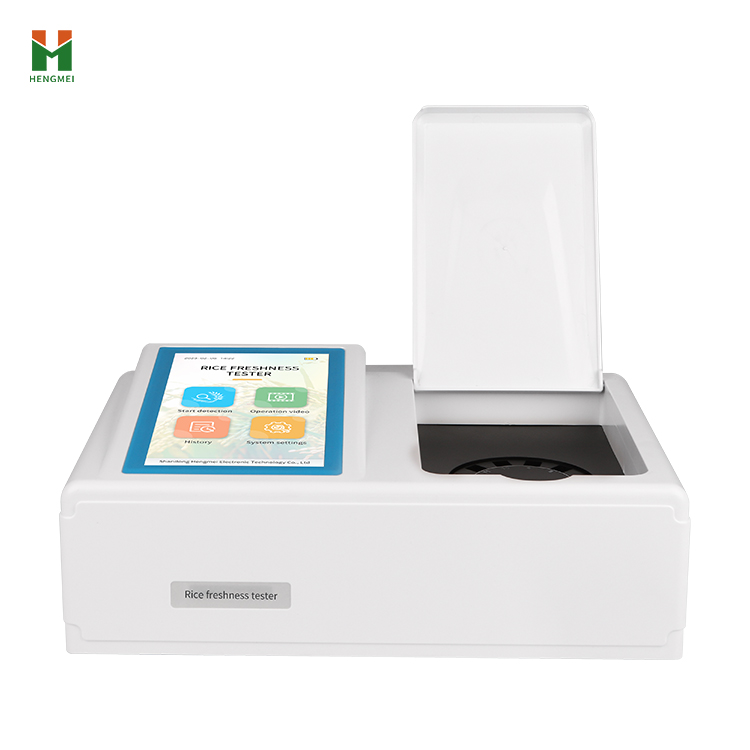Triple Advantages of Rice Freshness Testers:Efficiency, Accuracy, Convenience
Article Source: Hengmei Technology Release time:2025-09-29 16:51:16
Rice will gradually age during storage, leading to loss of nutrients, deterioration of taste, and even the production of harmful substances. The traditional freshness evaluation method relies on artificial sensory evaluation, which has problems such as strong subjectivity and inconsistent standards.
The rice freshness tester, based on the industry standard LS/T 6118-2017 "Determination and Discrimination of Rice Freshness in Grain and Oil Inspection", quantifies the freshness of rice through scientific methods, providing an objective quality evaluation basis for grain procurement, storage, processing, and sales.

Working principle of a rice freshness tester
1. Fundamentals of Scientific Principles
The working principle of the rice freshness tester is based on the quantitative detection of aldehydes and ketones produced during the aging process of rice. As the storage time prolongs, the fat in rice will gradually oxidize and decompose, producing a series of aldehydes and ketones. The content of these substances is negatively correlated with the freshness of rice.
2. The instrument testing process is as follows:
Rice samples to be tested will be husked and ground into third grade rice
Take 0.5-2g of rice sample and add a special freshness tester
Perform centrifugal treatment after oscillating and mixing
Detect the color change of the mixed solution after the reaction
Analyzing the degree of color change through a precision optical system
Calculate and display the freshness value (FD value, range 0-100 points) of the sample
Key Technology Analysis
The rice freshness tester adopts multiple advanced technologies to ensure the accuracy and reliability of the test results:
Precision optical detection system: using precision rotating detection device to ensure consistency of light source and eliminate detection deviation
Multi channel parallel processing: 12 independent detection channels can process 12 samples simultaneously, greatly improving detection efficiency
Intelligent data processing: The Android 7.1 intelligent system provides a user-friendly interface and powerful data processing capabilities
Environmental adaptability design: Operating temperature range of 18-25 ℃, humidity below 80% (no condensation), suitable for most grain storage environments
Technological advantages and innovation points
1. Convenient operation design
The rice freshness tester fully considers the actual needs of users and has significant advantages in terms of ease of operation:
Intuitive human-computer interaction: 10 inch touch screen LCD display, simple and clear operation interface
High degree of automation: from sample processing to result output, the entire process is automated, reducing human error
Quick detection: It takes at least 1 minute to complete the detection of 12 samples, meeting the needs of large-scale testing
Intelligent data management: Supports WiFi and Bluetooth transmission, and data can be wirelessly uploaded to the management platform
2. Environmental and safety features
The design of the grain freshness tester fully considers environmental and safety factors:
Environmental protection treatment: The tested waste liquid can be directly discharged into the sewer without special treatment requirements
Electrical safety: AC 200V~240V, 50/60Hz standard power supply, in compliance with electrical safety regulations
Data Security: The detection results are automatically saved and can be connected to a host computer to upload to the computer, avoiding data loss
Application Fields and Solutions
1. Main application scenarios
The rice freshness tester is widely used in multiple aspects of the grain industry:
Grain depot management: used for quality control of incoming goods and quality monitoring during storage
Rice processing enterprises: raw material procurement inspection and quality control during processing
Grain quality inspection agencies: Market supervision spot checks and arbitration inspections
Research Institute: Research on Grain Storage and Preservation Technology and Product Development
2. Industry pain point solutions
The rice freshness tester provides effective solutions to multiple pain points in the grain industry:
Acquisition dispute issues: Provide objective and unified freshness evaluation standards to reduce quality disputes
Storage management challenge: Regular testing can promptly detect changes in the quality of stored rice and guide scientific grain preservation
Processing quality control: ensuring the freshness of raw materials and improving the market competitiveness of finished rice products
Low regulatory efficiency: rapid batch testing capability significantly improves regulatory efficiency
As an important technological advancement in the field of grain quality inspection, the rice freshness tester has solved the problem of evaluating rice freshness through scientific and objective methods. Its fast, accurate, and convenient detection characteristics make it an important testing tool for quality control in various links of grain circulation.
Address of this article:https://www.kjhm.net/news/781.html
 Related News
Related News
-
24 / 2024-10
Transform Water Quality Monitoring with Our Advanced COD Ammonia Nitrogen Total Phosphorus Total Nitrogen Analyzer.
Learn more
-
17 / 2024-10
ATP Fluorescence Detector: A Fast And Accurate Tool For Microbial Detection.
Learn more
-
19 / 2024-12
High-precision infrared oil detector: an important tool to improve the efficiency of water quality detection.
Learn more
-
23 / 2024-09
Innovative Application Of Multi-parameter Water Quality Detector In Water Resource Management.
Learn more



 Current
Location:
Current
Location:





